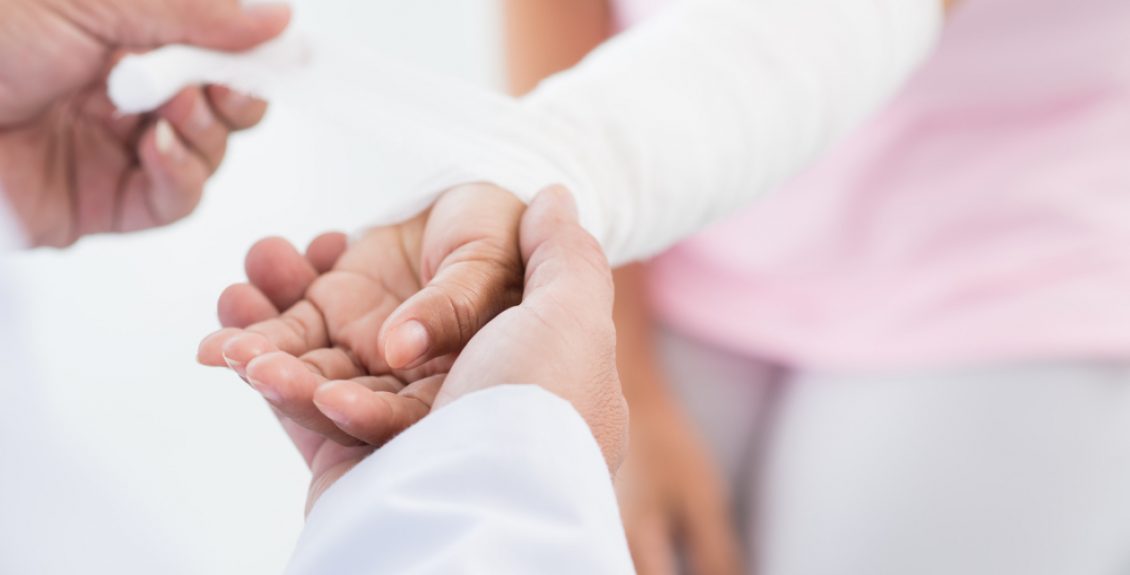Whether playing outdoors or inside, children often have a way of getting scrapes and cuts. Between running around with friends, playing in nature, participating in sports, and exploring every inch of a house, accidents are bound to happen when it comes to curious kids with a lot of energy.
While it is normal for children to experience minor accidents from time to time, wounds should always be addressed promptly to prevent infection, scarring, or further complications. Some wounds can be treated at home by a parent, while others require professional medical attention. Determining the severity of a laceration can help parents decide between at-home and professional care.
At-Home Care
For minor cuts, parents can use Band-Aids and antiseptics to treat the wound. Before treating the cut, wash your hands. After making sure your hands are clean, the next step is to stop the bleeding. While more minor scrapes often stop bleeding on their own, you might need to softly press the wound using a cloth or a bandage.
After the bleeding has stopped, ensure that the cut is cleaned thoroughly. Rinse the wound with water and gently wash the surrounding area with soap, taking care not to let soap enter the wound. If there is any dirt or debris, use tweezers that have been cleaned with alcohol. If all debris cannot be removed, you should consult a professional.
After cleaning the wound, apply an antiseptic ointment. Finally, cover the wound with a bandage or gauze. Make sure to change the covering daily and if it gets wet. Seek professional care if the wound worsens over time.
Professional Care
In some instances, wounds cannot be properly addressed at home. In this case, seeking professional care is necessary. Lacerations that require urgent care can be distinguished from minor cuts and scrapes in several ways.
Deep cuts should always be treated by a professional. This includes lacerations with visible tissue, fat, tendon, or muscle. Deep puncture wounds and cuts that result from dirty objects also require professional treatment.
Cuts caused by animal bites require serious attention as well. This helps address the risk of infection and illness that can be spread through animal bites, such as rabies, cellulitis, staph infections, and strep infections.
Further, cuts that bleed obsessively without stopping, cuts that are already showing signs of infection, and cuts that are not healing should be addressed by a professional.
Wounds that do not receive proper care can worsen over time, sometimes even leading to injuries or illnesses down the road. Immediate laceration repair helps to avoid these problems, allowing wounds to heal faster and preventing infections from forming.
Different Types of Wounds
At Just 4 Kids, we can treat lacerations and abrasions of varying severity at our pediatric urgent care centers. If it is difficult to determine the exact severity of a cut, we recommend consulting a professional.
We treat three main types of lacerations. The first kind is minor cuts and abrasions, which are superficial cuts that do not penetrate the skin deeply. Treating minor wounds like these involves cleaning, a few stitches, and basic aftercare.
We also treat deeper cuts. Because they can affect tissues beneath the skin or result in muscle damage, they should be addressed immediately. Due to their severity, treatment for this type of wound is more prolonged and involves more extensive aftercare.
Finally, we deal with complex lacerations. Sometimes, children’s wounds can become contaminated or jagged. We ensure these wounds are cleaned, sutured, and numbed when necessary.
Wound Treatment at Just 4 Kids Pediatric Urgent Care
Our wound treatment process consists of three steps in the clinic and a final step outside of the clinic. Regardless of wound severity, these steps help us to provide children with the highest standard of care.
Firstly, we conduct a wound evaluation. Before we can treat the injury, we must know its severity. We look at location, depth, and risk factors so that we can decide what to do next.
Next, we focus on repairing the wound. We usually combine various methods in order to address the wound, using stitches, staples, adhesives, and bandages as necessary.
We then focus on pain management. During the visit, we strive to make your children feel as comfortable and at ease as possible. We use a variety of strategies for pain management, including distracting your child, numbing options, and anesthesia.
The final part of treatment is aftercare and recovery, which takes place at home. This helps the wound heal and can also prevent infection. This part of the process is similar to the at-home care process for minor wounds and is crucial for the healing process.
We recommend keeping the wound area dry for a full day after it has been treated. Slowly, the skin can merge back together. After the first day, wash the wound area and dry it with a clean towel. Then, apply healing ointment. Finally, re-cover the wound with a clean bandage until it improves.
Make sure to monitor the wound for infection. If pain around the wound increases, redness or swelling occurs, pus seeps from the wound, or a foul smell emerges, the wound could be infected. We can conduct follow-up appointments to further treat the wound.
Local Pediatric Urgent Care
No matter the severity of a child’s wound, it should be addressed quickly. Whether you treat it at home or see a professional, treating the wound early can prevent infection and other complications from arising.At Just 4 Kids, we understand that it can be scary for parents and children alike when a child suffers an injury. We are here to support you every step of the way and help you figure out the best course of action. For any wound concerns, give us a call or walk in for prompt service.
